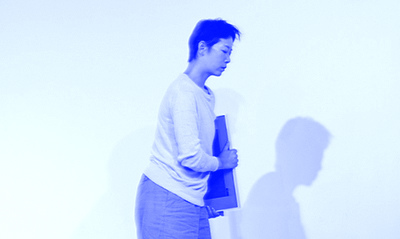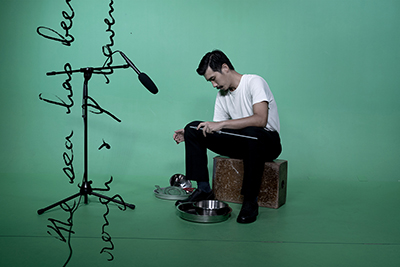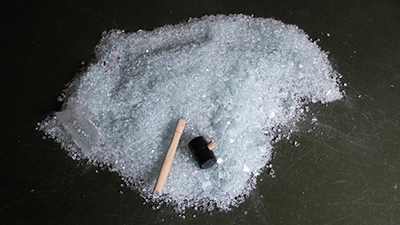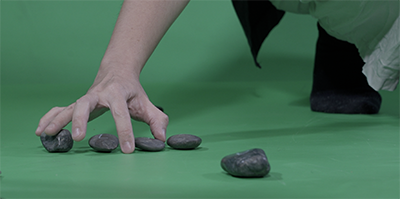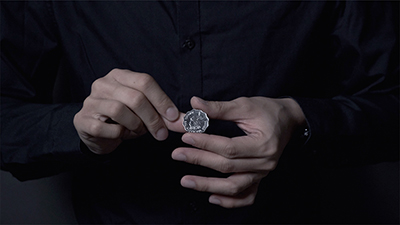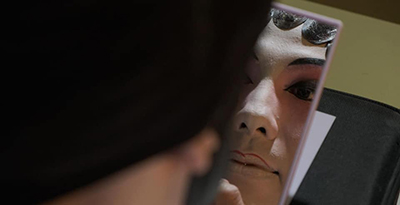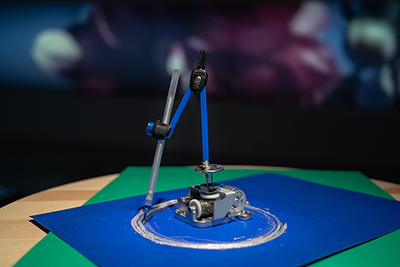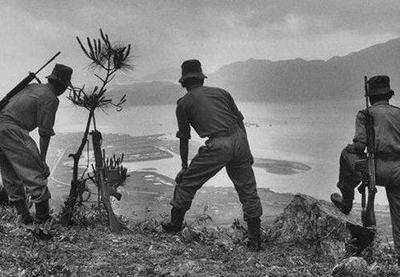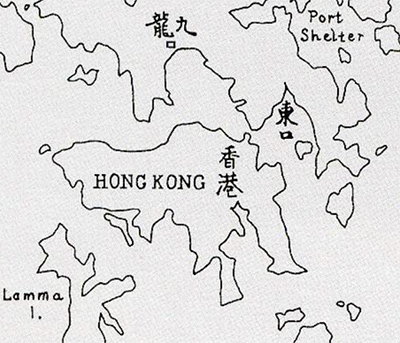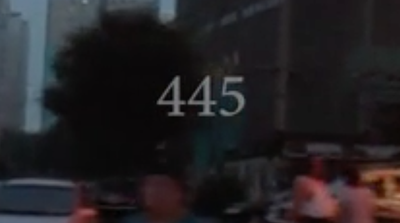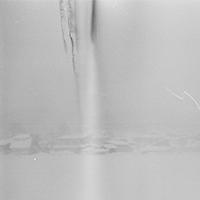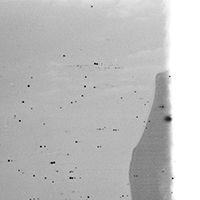
Take me to the River, Draw me a Star derived from Law’s introspection into her memories of waterbodies, to an exponential speculation of the cosmology, informed by the observation and surveying of the stars above our heads and the land we stand on.Based on her previous works with field research on New Territories rural, Law re-enacts a raining ritual to revisit the Hong Kong water crisis[1] in 1963, and unfold tales of stellar worship in ancient China. Through imitating the ways of creating scientific diagrams and surveys, Law reconstructs and probes the differences in concepts of time-space.
The exhibition constructs 3 timescapes by overlaying the year 1963 and 2023, and hence divides the space into 3 sections: Year 1963, 1963/2023 and 2023. Each section placed works that utilised cartography – creation of maps and star charts – to imitate, recreate and speculate how our ancestors communicated with deities and stars.
Year 1963 shows a 3-channel video installation re-fabricated with 1) An excerpt from Rainmaking[2], a 2-channel video, a part of her past work There Is No One Singing On The River. In the video the artist arranges pebbles to imitate the one’s movement and gesture in Bugang Tadou (步罡踏斗)[3], a Daoist ritual to call upon and worship the gods, 2) a computer–rendered rain-praying stele located on Wa Shan in Sheung Shui created by Law’s friend, and 3) a soundscape recorded when Law and her friend hiked to Wa Shan.
Year 1963/2023 shows 2 star charts rendered with online software sky & telescope, where Law inputs the longitude and latitude of Wa Shan in Sheung Shui, with 2pm on 2 June in 1963 and 2023 as the time reference respectively. At the exhibition opening, Law will perform in the format of Improvised Cinema, to create an overlapping star map of the Northern Hemisphere with a certain degree of deviation. At the same area there’s also Law’s hand-drawn star score by copying the Dunhuang Star Maps (705-710).
Year 2023 shows 3 hand-drawn copies of world maps created in 1888, 1898 and 1901 respectively. All of them are star-shaped and have the Arctic as the centre. Law invites her son to participate in the making with his favourite way of creating by filling out the colours. This section also exhibits Nesting Globes, the planet co-created by Law and her son.
French Geologist and anarchist Elisée Reclus believes that ‘Geography is nothing other than history in space, and history is geography over time.’[4]Take me to the River, Draw me a Star creates deviation in the process of imitating history and replicating timespace, speculating a new world of unknown and ignorance with uncertainties.
(Original text please refer to the Chinese version.)
[1] The rainfall in the 1963 summer was severely insufficient which could only supply the population for 43 days. The Hong Kong government implemented multiple times of water rationing. In June 1963, water supply was only available every 4 days and each for 4 hours only.
[2] In Rainmaking, Law reenacted the 1963 ritual to pray for rain according to the archival records in The Kung Sheung Daily News and Heritage of the North District. The Kung Sheung Daily News reported two hundred village women in Sheung Shui who set up an altar on the top of Wa Shan by Ng Tung River, praying for rain. According to the report, the ritual was to “first erect a green bamboo in front of the stele. Before the stele, offer three animal sacrifices and fruits, and six buckets of water, then hit the gongs and drums, chanting and gesturing with hands, praying to the heavens for rain, from time to time taking a sip of water, sometimes swallowing, sometimes spitting it out.” – The Kung Sheung Daily News, 3 June 1963.
[3] ‘Bugang Tadou’ (步罡踏斗) is a Daoist worshipping ritual, both word gang (罡) and dou (斗) refers to the Big Dipper. ‘Bu Gang Ta Dou’ is a set of steps according to how the stars are arranged in the Big Dipper, as if one is walking on the stars when worshipping.
[4] “L’histoire n’est que la géographie dans le temps, comme la géographie n’est que l’histoire dans l’espace. – Élisée Reclus,“L’Homme et la Terre” (The Earth and Its Inhabitants)
Take me to the River, Draw me a Star 為藝術家羅玉梅個人展覽,為香港逸東酒店於2023年地球月活動 Ways of Water 期下的節目。 Ways of Water 旨在探索香港的水道的生態與文化,審視於本地水域中動植物群和人類所面臨的威脅,從中了解和欣賞它們之間複離而微妙的共生關係。展覽由羅氏測繪與水體相關的記憶發展至推想丈量天象與地貌而生的宇宙觀:基於對新界河郊的田野考察的舊作延伸,羅氏以重演一場求雨祭祀回顧了香港歷史上的食水危機[1]與揭示中國古代的星體崇拜,亦通過摹製科學文獻重構不同時間與空間概念的差異與想像。
Take me to the River, Draw me a Star 羅氏以 1963 年及 2023 年構想一個重疊的時空,用「製圖」—— 繪製地圖和星圖作為手法,摹仿丶重塑丶推想先人們與神氏溝通與星體交流的經驗種種,並將展覧空間劃分為三個區域:1963、1963/2023 和2023。
1963:羅氏抽取了其舊作<河上沒有人唱歌>的雙頻同步錄像作品<雩祭>[2](2021) 中「步罡踏斗」[3]一幕—— 用河卵石排列出道教作法儀式中,禮拜星斗,召請神靈的步法與動作;與她邀請朋友以電腦軟件摹造位於上水華山的求雨石碑,以及她朋友上山考察石碑時巧遇的聲境,重新構成三頻錄像裝置。
1963/2023: 羅氏以網絡軟件 sky & telescope,輸入上水華山的經度 (longitude)和緯度 (latitude);並分別設定年份時間為1963年6月2日下午2時,以及2023年6月3日下午2時。軟件以運算的方式輸出兩張星圖 (star chart) 。羅氏以「電影現場」(Improvised Cinema) —— 行為表演的方式,製作一個重疊又帶點偏差的北半球星空。此區同時展出她臨摹敦煌星圖(705-710)的星譜。
2023 : 羅氏臨摹了三張於1888年1898年和1901年繪製, 以北極為中心的星型世界地圖,並邀請他四歲的兒子以他喜愛的「填色」手法參與製圖。此區同時展出由她與兒子製作的星體「瑪特廖什卡」[4] (Nesting Globes)。
法國地理學家,無政府主義者雅克·埃利澤·雷克呂斯 (Elisée Reclus) 認為「歷史只是時間上的地理,正如地理只是空間上的歷史。」(Geography is nothing other than history in space, and history is geography over time.) [5]
Take me to the River, Draw me a Star 在摹造歷史與時空的過程中製造偏差,又從這些不確定性 ,試圖推想/展開未知 (unknown) 無知 (ignorance) 的新世界。
[1] 1963年夏季恰逢乾旱,香港的降雨量嚴重不足,當時各水塘儲水量只夠全港人口用43日 ,供水量極為緊張。港府實施了一次比一次嚴格的制水措施:1963年6月時實施最嚴格措施,為每4天供水一次,每次4小時。
[2] 在<雩祭 >,羅氏依照《香港工商日報》及《北區風物志》的記載,模仿了1963年香港的一場民間求雨儀式。《香港工商日報》記錄了上水鄉村的二百餘名婦女於梧桐河畔的華山山頂設壇求雨。報道指「先是在石碑前,插下一棵青翠綠竹,碑前供奉丶三牲禮品菓物,及六桶清水,繼而敲起銅鑼皮鼓,口中唸唸有詞,有時以手作勢,哀求上蒼早降甘霖,不時則口含一啖清水,時飲時噴。」
– 香港工商日報,1963年6月3日。
[3] 步罡踏斗是道教齋醮儀式組成中常用的儀式,「罡」指天罡,「斗」指斗宿,兩者均指北斗星。步罡踏斗是在按一定的規定和程式在上面行走,步跡呈現北斗星的形狀分佈圖,宛如踏在北斗星上禮拜。
[4] 瑪特廖什卡為俄羅斯套娃的別名(俄語:матрёшка),是俄羅斯特產木製玩具,一般由多個一樣圖案的空心木娃娃一個套一個組成,一般在六個以上。
[5] 法文原文為“L’histoire n’est que la géographie dans le temps, comme la géographie n’est que l’histoire dans l’espace. – Élisée Reclus,“L’Homme et la Terre” (The Earth and Its Inhabitants)
(please click page 2 to continue reading)
